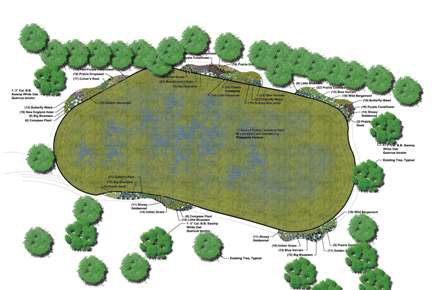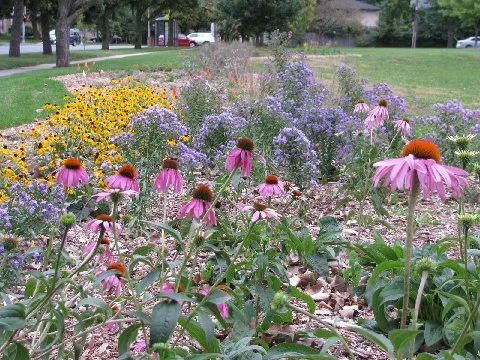Unless previously notified, all programs and classes are running as regularly scheduled today. Monday, 2/17/25
×
Unless previously notified, all programs and classes are running as regularly scheduled today. Monday, 2/17/25
Unless previously notified, all programs and classes are running as regularly scheduled today. Monday, 2/17/25

PARKS & FACILITIES
The Wilmette Park District is developing a Native Illinois Prairie garden within the detention area located at the north end of Centennial Park.
Seed plantings began in the fall of 2010. The project is expected to take a few years to become established. When complete it will attract numerous birds, butterflies and other wildlife.
Click Here![]() to download a PDF rendering of the 2010 garden site plan (shown on this page).
to download a PDF rendering of the 2010 garden site plan (shown on this page).


Citizens promptly petitioned for an election to organize a Park District. An election was held in January of 1908 and the first Board of Commissioners was designated. Of the 211 votes cast, 174 were in favor of establishing a park district and 37 were against. The Park District, a distinct and independent municipal body, encompassed the entire Village of Wilmette—which had a western boundary at the center line of Ridge Road. A portion of northeast Evanston was also included but later chose to be annexed to Evanston.
The new Park District immediately set out to acquire the canal’s “made land” and established a goal of creating a continuous lakefront park stretching north from the new harbor basin. Although the Park District did not officially acquire the canal acreage until state legislation was passed on May 25, 1911, a combination of purchases, property condemnations, lease agreements and a gift of land from Northwestern University soon resulted in one nearly continuous stretch of land between Lake Avenue to 70 feet north of Forest Avenue—including all riparian rights.
The first park development was begun in 1910 between Lake and Forest Avenues with the grading and installation of drainage, planting of trees and sodding of a bluff area which at the time was being eroded by waves. Street lights and sidewalks were also installed. Later construction of a pier for the Wilmette Harbor and placement of shore protecting bulkheads gradually developed a sandy beach area of 10 acres where only one and a half acres had originally been obtained. In 1916 the park on the bluff was named Ouilmette Park in honor of Wilmette’s first citizen, Anton Ouilmette, whose residence was located near the intersection of Lake and Michigan avenues.
The Park District discovered the acreage created by the canal excavation was almost exclusively an impervious blue clay. It was not until 1917 that the first trees could be planted in soil which had been coaxed into existence through a series of cow pea and mullet plantings which were plowed under to create humus matter. This area became known as Washington Park.
Between 1911-1914 the Park District purchased a total of 11 lots to create West Side Park, known today as Vattmann Park. In 1914 the Park District began purchasing land east of Michigan Avenue between Washington and Lake avenues in hopes of creating a continuous lakefront park. The Park District acquired the “Church Triangle” at the intersection of 11th Street, Lake and Wilmette avenues in 1916 and leased Bateman Park (Sheridan Road and Michigan Avenue) from the Sanitary District of Chicago the same year.
The canal right-of-way at the east end of Greenleaf Avenue became the site of the first public ice skating rink in Wilmette and the present day Wallace Bowl was used as the Village dumping ground for eight years. In June of 1916 the Wilmette Woman’s Club was granted permission to establish public bathing facilities along the lakefront at the foot of Lake Avenue and north about 300 feet. The Wilmette Beach was thus established. After one year of successful operation by the Woman’s Club, the Park District purchased the beach equipment and opened a municipal beach—taking over responsibility for the maintenance of the facility.
Phase One : Native upland prairie flowers and grasses surrounding part of the detention basin were planted in June of 2010, by Wilmette Boy Scout Troop 2. In November the one acre detention basin was planted with wetland prairie seeds. (Planning and design by Charlotte Adelman and 3D Design Studio).
Photo taken by Joe Bruner, Boy Scout Troop 2, in September 2010 of a portion of the upland prairie flowers and grasses planted in June 2010. Visitors observed goldfinches, native sparrows, bees and a variety of skippers and butterflies that were attracted to the upland prairie’s Purple Coneflowers, Orange Coneflowers, New England Asters and Blue Vervains. Although not shown in this picture, the prairie’s abundance of several colorful and fragrant species of native milkweeds attracted numerous female egg-laying monarch butterflies which produced monarch butterfly caterpillars.
Phase Two : Additional native upland prarie flowers and grasses were planted by Wilmette Boy Scout Troop 2 in June 2011 to create a 15-foot wide border surrounding the entire detention basin. (Planning and design by Charlotte Adelman and Joe Bruner).
Also harvested from the site in the blue protection covers are Swamp White Oaks that will be transplanted at a future date.
Join our list to stay up-to-date on all exciting and important things happening at the Wilmette Park District

Enriching the quality of community life through creative programming for people of all ages and abilities, while protecting open spaces and natural resources for future generations.
Quick LInks

Enriching the quality of community life through creative programming for people of all ages and abilities, while protecting open spaces and natural resources for future generations.

Enriching the quality of community life through creative programming for people of all ages and abilities, while protecting open spaces and natural resources for future generations.
Quick LInks
2025 © Wilmette Park District. All rights reserved.
Designed, Conceptualized and Developed by OnPoint Insights LLC